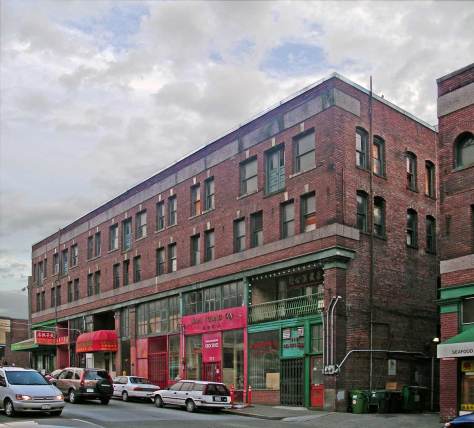


Here we see – above – what The Seattle Times for Sept. 5, 1909 headlined the “Unique and Attractive ‘Seattle Day’ Decoration of Standard Furniture Company’s Store.” Follows the Times reporter’s often thrilled description of “the most unique and attractive store decoration ever seen in Seattle.” We quote.
“The idea typifies the ‘Spirit of Seattle’ with a full life-sized figure of Chief Seattle in his ‘glory paint and trappings’ in the foreground surrounded by a forest of real evergreen trees, his Indian tepee . . . and tripod from which actual red fire is produced.” Behind this “real Indian camp” is a “scenic background of Mount Rainier, over which appears to be the real rays of the shimmering moon. The entire effect is spectacular and realistic . . . Surrounding the immense glass canopy over the store’s entrance are eight large cast ivory figures representing ‘Seattle’ with outstretched arms, from which a magnificent series of hundreds of colored electric lights and floral festooning is hung.”
The following day, Sept 6, was “Seattle Day” at the Alaska Yukon and Pacific Exposition (AYP) on the University of Washington campus. Above the front door of this furniture emporium is hung the slogan of the day, “We’ll be There!”
The Schoenfelds were often “there” for Seattle celebrations. During a long career of sales at Second and Pine they used the front door and Second Avenue side of their skyscraper for many dazzling effects. For instance, after “Seattle Day” the chief was replaced with what the Times reported on Oct. 3, as “an immense oil painting of President Taft (for his visit to AYP) surrounded with hundred of yards of national colored bunting mounted with an immense gold eagle and a large electric flag which when lighted gave a brilliant ‘wave effect’.”
Then and now Captions Together: Raised up in 1905-07 while Denny Hill was being cut down behind it the Schoenfeld’s family new company furniture store was a fine example of what architectural historian Rev. Dennis Andersen – minister to both landmarks and souls — describes as architect Augustus Warren Gould’s, “restrained sense of ornament, favoring instead to accent the splendor of site arrangement and visibility of the structure.” Much later the building was stripped of what ornament it had – including its terra-cotta tiling – in what must have been another of those fleeting anxieties about what is in or out of style.


















